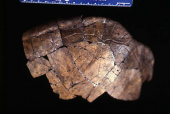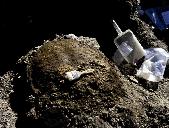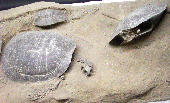|
 See More Images See More Images

Baptemys garmanni
© 1998 UCMP

Late Cretaceous Turtle
© 2005 Utah Geological Survey

Chrysemys sp.
© 2005 N. Lindsley-Griffin, University of Nebraska State Museum
|
What are Turtles? Turtles are a very distinctive group of reptiles that have a curved or dome-shaped shell covering most of their body. Tortoises are a group of turtles that are highly adapted for a terrestrial mode of life, but other turtles can be found in forests, streams, ponds, and oceans. Modern turtles have a beak, but lack teeth. Many turtles can pull the head, limbs, and tail into the shell for protection, and precisely how they do this is one of the characters used to divide turtles into subgroups. Turtles first appear in the Late Triassic, but they are so distinct even in the fossil record that their exact relationship to other reptiles is still under study. First known fossil occurrence: Triassic. Last known fossil occurrence: Quaternary. This group has living relatives. |
Fossils through time:
Choose a time period to see what life was like:
|
|